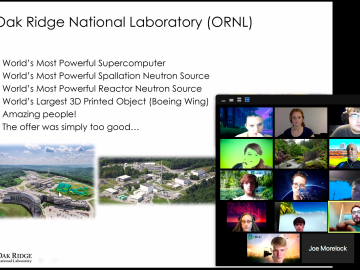
Filter News
Area of Research
- (-) Clean Energy (69)
- (-) Materials (50)
- (-) Materials for Computing (5)
- Advanced Manufacturing (4)
- Biology and Environment (17)
- Climate and Environmental Systems (2)
- Computer Science (2)
- Energy Sciences (1)
- Fusion and Fission (5)
- Fusion Energy (5)
- Isotopes (4)
- National Security (12)
- Neutron Science (27)
- Nuclear Science and Technology (22)
- Nuclear Systems Modeling, Simulation and Validation (2)
- Quantum information Science (3)
- Supercomputing (38)
News Topics
- 3-D Printing/Advanced Manufacturing (22)
- Advanced Reactors (4)
- Artificial Intelligence (4)
- Big Data (4)
- Bioenergy (10)
- Biology (1)
- Biomedical (4)
- Biotechnology (1)
- Chemical Sciences (2)
- Clean Water (1)
- Climate Change (7)
- Composites (1)
- Computer Science (15)
- Coronavirus (8)
- Critical Materials (2)
- Cybersecurity (2)
- Decarbonization (1)
- Energy Storage (19)
- Environment (19)
- Exascale Computing (2)
- Grid (6)
- High-Performance Computing (1)
- Isotopes (1)
- Machine Learning (6)
- Materials (2)
- Materials Science (34)
- Mathematics (2)
- Microscopy (6)
- Molten Salt (1)
- Nanotechnology (14)
- National Security (1)
- Neutron Science (14)
- Nuclear Energy (5)
- Physics (8)
- Polymers (6)
- Quantum Science (5)
- Security (1)
- Summit (5)
- Sustainable Energy (21)
- Transformational Challenge Reactor (4)
- Transportation (14)
Media Contacts

Oak Ridge National Laboratory researchers have developed artificial intelligence software for powder bed 3D printers that assesses the quality of parts in real time, without the need for expensive characterization equipment.

Scientists at the Department of Energy’s Oak Ridge National Laboratory have a powerful new tool in the quest to produce better plants for biofuels, bioproducts and agriculture.

Each summer for the last 30 years, students and teachers from across Appalachia have travelled to ORNL for a unique STEM summer camp experience – the Appalachian Regional Commission/ORNL Science-Technology-Mathematics Institute.

Oak Ridge National Laboratory researchers have developed a machine learning model that could help predict the impact pandemics such as COVID-19 have on fuel demand in the United States.

Oak Ridge National Laboratory scientists evaluating northern peatland responses to environmental change recorded extraordinary fine-root growth with increasing temperatures, indicating that this previously hidden belowground mechanism may play an important role in how carbon-rich peatlands respond to warming.

An all-in-one experimental platform developed at Oak Ridge National Laboratory’s Center for Nanophase Materials Sciences accelerates research on promising materials for future technologies.

Real-time measurements captured by researchers at ORNL provide missing insight into chemical separations to recover cobalt, a critical raw material used to make batteries and magnets for modern technologies.

Joe Hagerman, ORNL research lead for buildings integration and controls, understands the impact building technology innovations can have during times of crisis. Over a decade ago, he found himself in the middle of one of the most devastating natural disasters of the century, Hurricane Katrina.

Scientists seeking ways to improve a battery’s ability to hold a charge longer, using advanced materials that are safe, stable and efficient, have determined that the materials themselves are only part of the solution.

ORNL researchers have developed an intelligent power electronic inverter platform that can connect locally sited energy resources such as solar panels, energy storage and electric vehicles and smoothly interact with the utility power grid.


